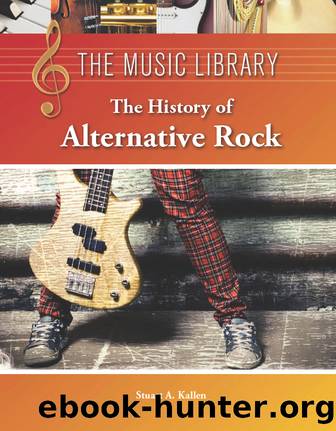The History of Alternative Rock by Kallen Stuart A.;

Author:Kallen, Stuart A.;
Language: eng
Format: epub
Tags: The History of Alternative Rock
ISBN: 5538454
Publisher: Greenhaven Publishing LLC
Published: 2018-06-29T00:00:00+00:00
Motorhead, seen here in London in 1978, was the first thrash metal group.
As with other musical styles, there were those who were willing to take an extreme sound and make it even more intense. In this way, thrash metal spawned the death metal sound in the late 1980s. Death metal devotees gave their bands morbid names such Napalm Death, Carcass, Dismember, and Malevolent Creation. These groups played extremely slow, lumbering, distorted heavy metal. Singers sang persistently about death, gore, suffering, torture, and pain in growling or shrieking voices that sounded like monsters from horror films.
The Jangle and Mystery of R.E.M.
While most death metal bands attracted only small cultlike followings, indie rock blew up in a big way at the end of the 1980s. This was due, in part, to R.E.M, a band with an MTV- and radio-friendly sound that appealed to fans across the musical spectrum. R.E.M. was founded in 1980 by singer Michael Stipe, guitarist Peter Buck, bassist Mike Mills, and drummer Bill Berry. All attended the University of Georgia in Athens, where the growing indie music scene helped propel a local new-wave band, the B-52s, to national fame in the early 1980s.
The B-52sâ infectious mix of dance, surf, and punky rock music and humorous videos for hits like âRock Lobsterâ and âLove Shackâ made the group MTV favorites. The groupâs fame, however, was soon eclipsed by R.E.M., which built a substantial fan base playing local bars in Athens. R.E.M.âs first single, 1981âs âRadio Free Europe,â presented a classic mix of musical styles that would come to define alternative rock in later years. Although the band is often mocked for its unintelligible lyrics, this characteristic would become something of an R.E.M. trademark. Jason Crock, a contributor to the alternative music website Pitchfork, explains:
[The songâs] slashing chords may have had roots in punk, but the band replaced all their bile and angst with jangle, mystery, and inscrutability. . . . They aimed for a kind of danceable folk-punk . . . and the result was a little left of the mark, but it sounded like little else around . . . [and] altered the face of underground rock; it was the mumble heard âround the world.63
After the release of their debut album, Murmur, R.E.M. followed the classic path to stardom for an indie band. Driven by a do-it-yourself spirit, the group toured relentlessly, playing big-city theaters and small-town dives. R.E.M. annually produced critically acclaimed albums like Fables of Reconstruction and Lifeâs Rich Pageant, which only sold a few hundred thousand copies.
R.E.M.âs slow climb to stardom ended in 1987, when they achieved widespread fame with the album Document, which produced two hit singles, âThe One I Loveâ and âItâs the End of the World as We Know It (And I Feel Fine).â With its rapid-fire lyrical delivery, dynamic beat, and catchy chorus, âItâs the End of the Wordâ helped spark a back-to-the-garage movement that spawned dozens of indie bands, including the Pixies, Dinosaur Jr., and My Bloody Valentine.
By the time Document was released, R.
Download
This site does not store any files on its server. We only index and link to content provided by other sites. Please contact the content providers to delete copyright contents if any and email us, we'll remove relevant links or contents immediately.
| Biographies | Classical |
| History | Instruction |
| Popular | Rap & Hip-Hop |
| Rock | Songbooks |
Creative and Successful Set Designs by Muffatti Todd;(166)
Chris Legaspi. Life Drawing for Artists. Understanding Figure Drawing Through Poses, Postures, and Lighting by Unknown(151)
How to Draw Gothic Fantasy Art by Steve Beaumont(133)
Fake News and Media Bias by Lucian Vance(129)
William Williams Documents Ellis Island Immigrants by Rebecca Rowell(127)
Magic Doctor by Novel Cat(91)
Expressing the Inner Wild : Tattoos, Piercings, Jewelry, and Other Body Art by Stephen G. Gordon(91)
NASA Takes Photography into Space by Arnold Ringstad(83)
The History of Alternative Rock by Kallen Stuart A.;(82)
Native Actors and Filmmakers by Gary Robinson(77)
The History of Theatre by Ann Hosein(76)
Fashion Science by Jane P. Gardner(71)
An A-Z of JRR Tolkien's the Hobbit by Oliver Sarah(67)
Imperial Ambitions Conversations on the Post-911 World by Unknown(67)
American R & B: Gospel Grooves, Funky Drummers, and Soul Power by Aaron Mendelson(65)
Play Piano in a Flash for Kids! by Scott Houston(60)
Trumpet Warm-up 2 by Timothy Leasure(56)
Music by Russell Kuhtz(54)
An A-Z of JRR Tolkien's The Hobbit by Oliver Sarah(53)
